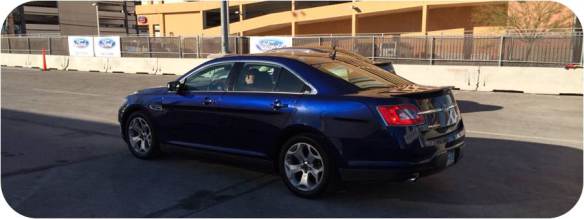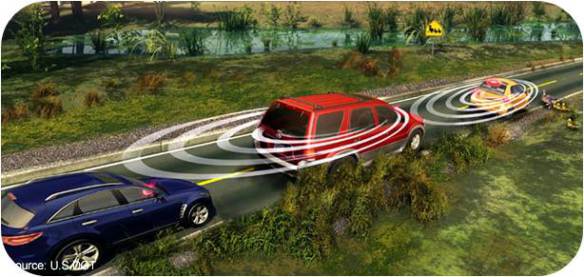I spent much of December and the entire plane ride out to CES reading functional and technical documents on the DOT’s Connected Vehicle Safety program so when I saw that Ford had a test version of the technology that I could check out I was very excited.

In case you aren’t familiar with the Connected Vehicle program, it is a safety program designed to have cars communicate with each other so that drivers can be made aware of other vehicles and what they are doing.

The picture above is a good example of how this can be beneficial. Suppose the yellow car in front slams on its breaks to avoid the ducks entering the roadway. Unfortunately the driver of the red SUV is in the middle of reading a text message and doesn’t notice the yellow car’s brake lights. Because the red SUV is blocking his view, the driver of the blue car doesn’t see the yellow car stopping either. In this scenario, a three car accident is very likely.
However, with connected vehicle technology the drivers in both the red SUV and the blue car would be notified the instant that the yellow car slammed on its brakes. This is because that technology has each car broadcasting out a basic safety message which includes location, speed and braking information ten times a second. When the systems in the blue and red vehicles get the message, they will instantly notify its driver so that the appropriate action can be taken. In this case, slamming on the brakes and avoiding hitting the car in front of them.
This is just one of the scenarios that this technology should help with. One of the big challenges in this area, prior to the introduction of fully driverless vehicles, is how should the driver be notified when an issue arises. A lot of research is being done in this area by the DOT, automobile companies and research institutes at major universities like Virginia Tech and Stanford.
Given this, it was very interesting to see what Ford is doing. During CES, Ford setup a small test track in a parking lot outside the convention center in Las Vegas. There were three Ford cars as part of the test. I rode in a Taurus.
In the first test, we went forward and one of the other cars was in the lane next to us in our blind spot. When we put on our blinker to turn, the seat nudged us from behind and a set of red lights was displayed in a heads up display in the windshield. This seemed like a pretty good indication that something was amiss. We went through a number of other scenarios including one like in the picture above. In this case, we got the red lights in the windshield and both sides of the seat indicated a problem.
The last scenario was at an intersection with a truck parked to block our view of the cars driving on the cross street. One of the other cars was coming at a high speed from our right. As we approached the intersection, the seat again warned us on the proper side but this time the lights in the dash flashed from right to left indicating a problem coming from the right. All in all, it seemed very effective. The middle part of this video from c|net, the part of V2V, shows exactly what Ford was demoing at CES.
As a father of three young adult drivers and a driver myself, I see this as a huge safety enhancement and something that the government should be mandating in the next generation of vehicles.
John
